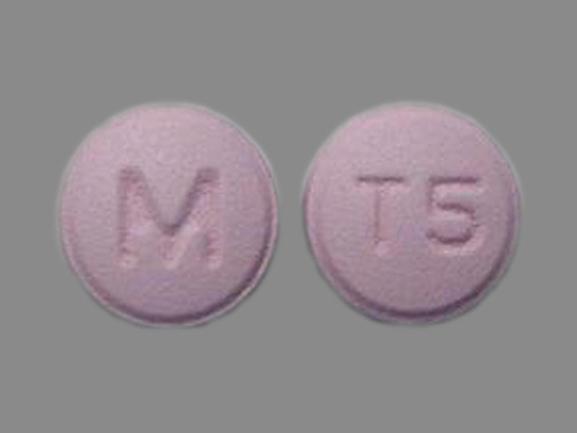Trifluoperazine Dosage
Medically reviewed by Drugs.com. Last updated on Apr 14, 2025.
Applies to the following strengths: 10 mg/mL; 2 mg/mL; 1 mg; 2 mg; 5 mg; 10 mg
Usual Adult Dose for:
Usual Geriatric Dose for:
Usual Pediatric Dose for:
Additional dosage information:
Usual Adult Dose for Schizophrenia
Initial dose: 2 to 5 mg orally 2 times a day
Maintenance dose: 15 to 20 mg/day
Maximum dose: 40 mg/day
Comment:
- Most patients should reach therapeutic levels in 2 to 3 weeks.
Use: Management of schizophrenia
Usual Adult Dose for Anxiety
Recommended dose: 1 to 2 mg orally 2 times a day
Maximum dose: 6 mg/day
Duration of therapy: Up to 12 weeks
Comment:
- The lowest effective dosage should be used for the shortest duration of time.
Use: Treatment of non-psychotic anxiety
Usual Geriatric Dose for Schizophrenia
Initial dose: 2 mg orally 2 times a day
Maintenance dose: 15 to 20 mg/day
Maximum dose: 40 mg/day
Comment:
- Most patients should reach therapeutic levels in 2 to 3 weeks
Use: Management of schizophrenia
Usual Geriatric Dose for Anxiety
Initial dose: 1 mg orally 2 times a day
Maximum dose: 6 mg/day
Duration of therapy: Up to 12 weeks
Comments:
- Due to the long half-life of this drug, this drug may be given as a once a day dose.
- The lowest effective dosage should be used for the shortest duration of time.
Use: Treatment of non-psychotic anxiety
Usual Pediatric Dose for Schizophrenia
6 to 12 years:
- Initial dose: 1 mg once a day OR 2 times a day
- Maintenance dose: 1 to 15 mg/day
12 years and older:
- Initial dose: 2 to 5 mg orally 2 times a day
- Maintenance dose: 15 to 20 mg/day
- Maximum dose: 40 mg/day
Comments:
- Pediatric patients should be closely monitored or hospitalized.
- Dosing should be determined by symptom severity and the weight of the child. Patients may undergo gradual dose titration until symptoms are controlled or side effects become intolerable.
- Older patients with severe schizophrenia may require doses greater than 15 mg/day to manage their symptoms.
- Most patients should reach therapeutic levels in 2 to 3 weeks.
Use: Management of schizophrenia
Renal Dose Adjustments
Data not available
Liver Dose Adjustments
Use is contraindicated in patients with known liver damage.
Dose Adjustments
Small/emaciated patients should begin on the lower end of the dosing range for the management of schizophrenia.
Precautions
US BOXED WARNING:
- INCREASED MORTALITY IN ELDERLY PATIENTS WITH DEMENTIA-RELATED PSYCHOSIS: This drug has an increased risk of mortality when administered to elderly patients with dementia-related psychosis. Elderly patients with dementia-related psychosis treated with antipsychotic drugs have an increased risk of death. This drug is not approved for use in patients with dementia-related psychosis.
Safety and efficacy have not been established in patients younger than 6 years.
Consult WARNINGS section for additional precautions.
Dialysis
Data not available
Other Comments
Administration advice:
- Due to the long half-life of this drug, this drug may be given as a once a day dose.
- Use of the liquid formulations should be considered in patients with difficulty taking tablets, who are uncooperative, or pediatric patients.
Storage requirements:
- See manufacturer product information.
Reconstitution/preparation techniques:
- See manufacturer product information.
General:
- All patients on prolonged treatment should be reassessed regularly.
- Use should be avoided as first-line therapy for non-psychotic anxiety.
- This drug has not been effective in the management of behavioral complications in patients with intellectual disabilities.
- Some capsule formulations are equivalent to tablet formulations, but are given once a day. The manufacturer product information should be consulted for more details.
- Treatment is not indicated for symptom improvement and relapse prevention in depressive psychoses.
Monitoring:
- Periodic WBC with differential tests, especially in patients with signs/symptoms of infection/sore throat or with a history of low WBCs or drug-induced neutropenia/leukopenia
- Periodic liver function tests, with increased frequency in patients with signs/symptoms of liver dysfunction
- Blood pressure, especially in patients with impaired cardiovascular systems
- Eye examinations, especially in patients on prolonged treatment
- Heart rate, especially in patients with arrhythmias and/or taking QT prolonging drugs concurrently
- Periodic renal function tests
Patient advice:
- Patients should be warned to avoid abrupt discontinuation of this drug.
- Patients should be instructed to immediately report any signs/symptoms of neutropenia/leukopenia, neuroleptic malignant syndrome, or tardive dyskinesia.
- Inform patients that this drug may cause or impair mental/physical abilities, and they should avoid driving or operating machinery until the full effects of the drug are seen.
- Patients should be advised to speak to a healthcare provider if they are pregnant, intend to become pregnant, or are breastfeeding.
Frequently asked questions
More about trifluoperazine
- Check interactions
- Compare alternatives
- Pricing & coupons
- Reviews (23)
- Drug images
- Side effects
- During pregnancy
- Drug class: phenothiazine antipsychotics
- Breastfeeding
- En español
Patient resources
Professional resources
Related treatment guides
See also:
Further information
Always consult your healthcare provider to ensure the information displayed on this page applies to your personal circumstances.


